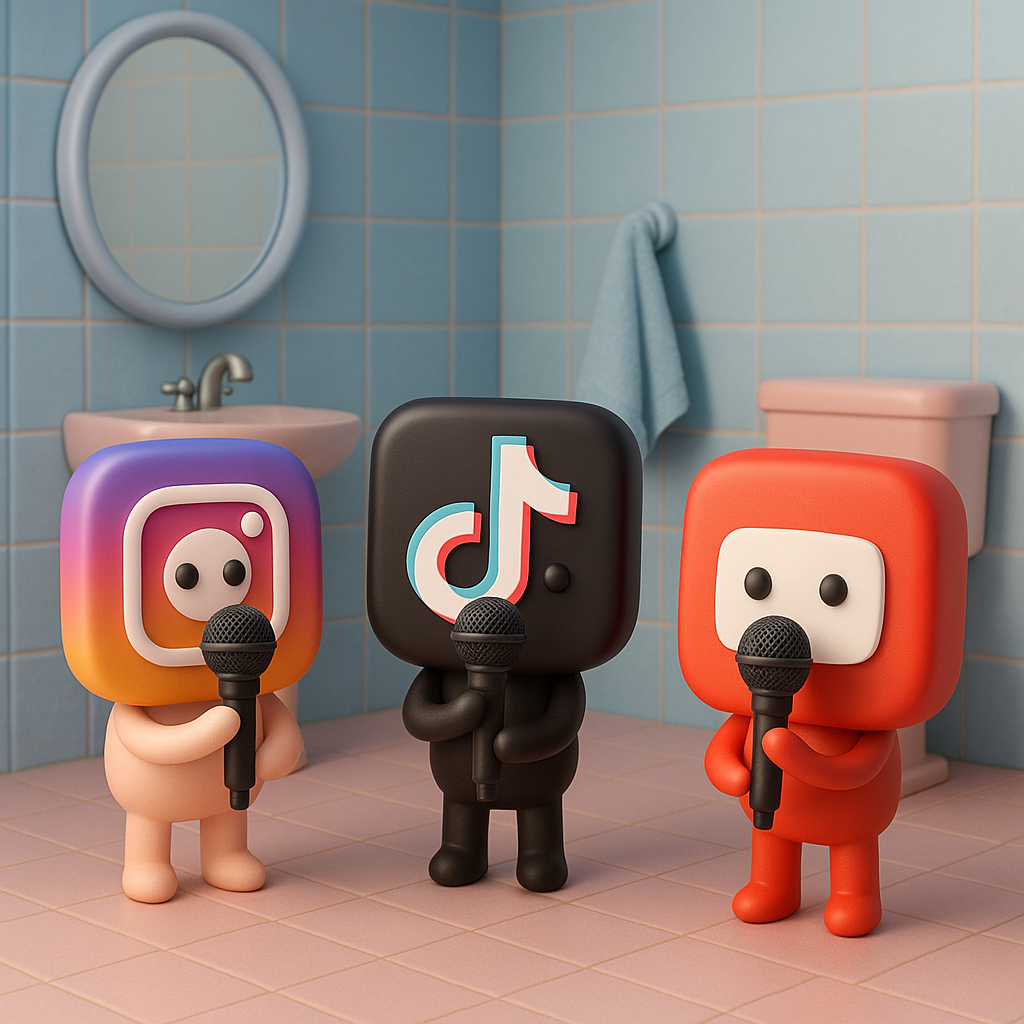
Why Audio Quality Matters: How Social Media Algorithms React to Echoey "Bathroom Posts"
In the age of video-first content, audio quality is no longer an afterthought it's a critical factor in how your posts are received and ranked. Whether you're on TikTok, Instagram Reels, or YouTube Shorts, the platform’s algorithm is quietly assessing your video’s sound just as closely as it evaluates visuals, captions, and engagement.
One major red flag? Echoey, “bathroom-like” audio.
🎧 What Is "Bathroom Audio"?
"Bathroom audio" refers to recordings with excessive reverb or echo, commonly caused by recording in small, hard-surfaced rooms like bathrooms or empty spaces. These environments bounce sound waves back into the mic, creating a hollow, tinny effect. Even if the visuals are sharp, the poor audio cues can signal "low production value" to both the algorithm and the viewer.
🤖 How Algorithms Detect Audio Quality
Modern social media platforms use machine learning to assess audio clarity. Here's how:
-
Echo detection: Platforms like TikTok and YouTube can detect high levels of reverb and classify them as low-quality audio.
-
Speech intelligibility models: These models determine how easy it is to understand spoken content. If your voice sounds muffled, distant, or buried in echo, the system might deprioritize your video in feeds.
-
Background noise & distortion filters: These algorithms are trained to detect poor recording environments—bathroom reverb, fan noise, or overly compressed sound are all quality indicators.
While they won’t always penalize poor audio outright, they use it to predict how long people will stay on your video. If users swipe away quickly due to unpleasant sound, the algorithm takes that as a negative signal and pushes the post down in visibility.
📉 What Poor Audio Signals to the Algorithm and Viewers
-
Low retention: Bad audio can cause viewers to bounce within seconds, even if your content is valuable.
-
Decreased shares and saves: If viewers can’t understand or enjoy what you’re saying, they won’t share it.
-
Lower engagement metrics: Bad sound = fewer comments, fewer likes. And algorithms love engagement.
✅ How to Avoid the “Bathroom Effect”
-
Avoid hard-surfaced rooms for filming unless treated with soft materials.
-
Use an external mic (even wired earphones are better than raw phone audio).
-
Edit your audio using free tools like CapCut, Adobe Premiere Rush, or mobile apps that reduce echo and background noise.
-
Test your space: Clap once. If you hear a strong echo, your voice will too.
🔁 Bonus: What Happens If You Fix the Audio?
If you improve the audio after posting (especially on platforms that allow replacing audio or re-uploading), your content may perform better. Some creators report higher watch times and better engagement after fixing audio and re-uploading the same video.
Final Thoughts
The algorithm doesn't just see it listens. Echoey, reverb-heavy audio might seem like a small issue, but it can seriously drag down your reach. Think of audio as your hidden superpower: when it's clean and crisp, your message is clearer, your audience is happier, and the algorithm takes notice.
So next time you're about to film in the bathroom don't. Your future views might thank you.
Here are several types of clip-on microphones you can use while recording with your iPhone, along with their key features:
🎤 1. Wired Lavalier Microphones (3.5mm or Lightning)
-
Examples: BOYA BY-M1, Rode SmartLav+, Shure MVL
-
Connection:
-
Older iPhones: 3.5mm jack (with adapter)
-
Newer iPhones: Lightning connector
-
-
Pros: Reliable, no battery needed, plug-and-play
-
Cons: Limited by cable length, requires adapters on newer iPhones
📱 2. Lightning Lavalier Microphones
-
Examples: Sennheiser ClipMic Digital, Shure MVL with Lightning adapter
-
Connection: Direct Lightning port
-
Pros: Optimized for iOS, high-quality digital audio
-
Cons: More expensive, no analog fallback
🔌 3. USB-C Lavalier Microphones (For newer iPads or iPhone 15 and up)
-
Examples: Rode Lavalier II with USB-C adapter, Boya BY-M3
-
Pros: High compatibility with latest Apple devices, digital signal
-
Cons: May require compatibility check for each app
📶 4. Wireless Lavalier Systems
-
Examples: Rode Wireless GO II, DJI Mic, Hollyland Lark M1
-
Connection: Receiver plugs into Lightning/USB-C, mic clips onto clothing
-
Pros: Freedom of movement, great for interviews or walk-and-talk
-
Cons: Higher cost, needs charging
📲 5. Bluetooth Clip-On Microphones
-
Examples: SabineTek SmartMike+, Instamic Pro
-
Connection: Pairs via Bluetooth
-
Pros: No cables, mobile-friendly
-
Cons: Latency, may be less stable than wired or RF systems
🧩 Tips for Using Clip-On Mics with iPhone:
-
Use Apple's Lightning to 3.5mm adapter for analog mics.
-
For highest quality, look for MFi-certified (Made for iPhone) options.
-
Test levels before recording—iPhone Voice Memos or Filmic Pro can help.
-
Use a wind muff (deadcat) if filming outdoors to cut out wind noise.